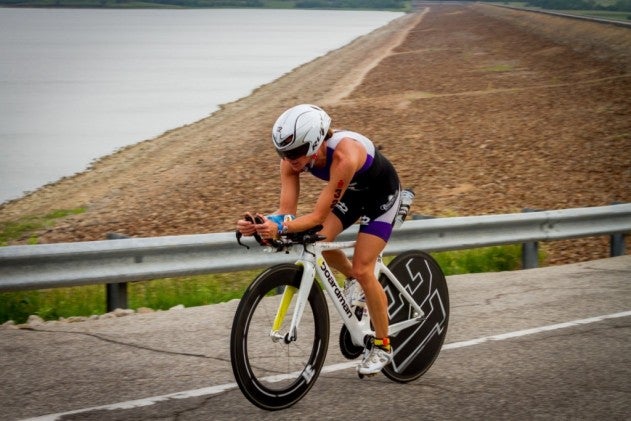Dispatch: 4 Swim Drills From Amanda Stevens

Photo: Randy Sadler
Following the off-season, many of us go through a phase of getting back into training–and struggling somewhat in the process. What better time, though, to take a break from routine training sessions and instead focus on form, building a base of improved technique with which to tackle the months ahead. Winter is the perfect time to fine-tune your swim stroke, and mastering a few expert tips will go a long way toward enhancing your effort in the water. Ironman champion Dr. Amanda Stevens, a first-out-of-the-water fixture at nearly every event she races and a former all-American high school and collegiate swimmer, has spent more time than most traversing the black line. Here, she shares four of her favorite drills to hone in on various aspects of freestyle.
“For all drills, except the Tube Drill, I use fins!” says Stevens. “Fins help you move through the water at a speed closer to your swim speed and can help with body position by giving you some lift and buoyancy.”
If you’d like Stevens’ help with your swim–or any/all aspects of triathlon–she enjoys coaching both age group and professional athletes.
RELATED – ProFile: Amanda Stevens
Tube Drill
This works on body rotation, core stability and also strength and power in your stroke. If you are having difficulty with this one, try it with a pull buoy. As you build strength, you can advance to tube only. The tube is an old bike tire tube. Cut out the valve stem and cut and tie the tube to a length where it will fit snuggly in a figure-eight around your mid-calf or ankle (I prefer mid-calf). Then swim!
RELATED: Three Levels Of Band Work
Straight Arm Swim
The focus of this drill is exaggerating the depth of your pull. Your arm is straight while under the water (the above water arm can be either bent or straight) with fingertips pointing to bottom and palm facing the wall behind you. You do not want to swim with a straight arm all the time, but this drill will allow you to feel a complete range of depth. A shallow pull, by contrast, would be all the way up by your stomach. Experiment with each end of the range and then find your sweet spot somewhere in between. A deep pull is especially important for triathletes, as most races are in open water. The surface water is more turbulent and you want to pull where the water is smoother.
RELATED: In Defense Of Swim Drills
Single Arm
This drill is used to isolate each of your arms. This will improve your feel for the water and due to the nature of this drill it will also help you work on your breath and stroke timing and body rotation. There are several ways to perform this drill:
A: Arm in front. When doing this, the arm you are not using remains out in front. You will breath towards the arm that is swimming. Since one hand remains out in front, your swimming arm will ‘catch-up’ to it every stroke cycle. Normal swim timing is ‘almost caught up’, which means that about the time your swimming arm gets ready to enter the water your other hand starts the catch phase. Focus on the arm out in front while doing this drill; you want it to be slightly underwater and straight out in front in a relaxed position. You do not want it stretched out or reaching.
B: Arm at side. When doing this variation, the arm you are not using rests at your side and you will breath away from the arm that is swimming. Focus on your body roll: keep your hips and shoulders together, initiate power and roll from the hips and try to have equal roll to both sides.
C: Single arm with kickboard. If you’re having trouble with this drill, try it first with a kickboard held in front with the non-swimming arm. The swimming arm will make contact with the board on each stroke, then slide off the board as you begin the stroke.
RELATED: Pick The Swim Drill For Your Weakness
Shark
To do this drill, take three strokes and then pause one arm above the water. Your paused hand will be at or just in front of your shoulder and your other arm will be extended out in front of you. Pause for a count of 3-5, then start swimming again. Take 3-5 strokes and pause again (this time your opposite arm will be out of the water). When paused, you want to be on your side and as you start to swim again, drive your top hip down to initiate power. I like to use this drill rather than a side pause drill, where your arm remains at your side while pausing. Most swimmers use a windmill style stroke, where their arms are always opposite one another, with one in front and one in back. However, an ideal stroke is almost caught up. Use this drill to take out the pause in the back of your stroke and practice a quick but relaxed recovery.